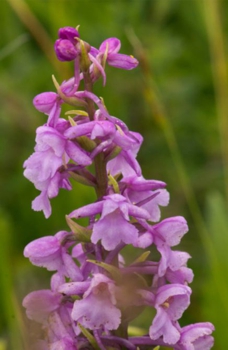Chalk Fragrant-orchid Gymnadenia conopsea … Tegeirian Per
June – July
Identification: 15 – 30cm. The inflorescence is narrow and pointed and a uniform pink colour. Each flower is overall pink with a three-lobed lip each lobe being of about a similar size. The lateral sepal is usually slightly downward pointing and parallel-sided. It has a slightly sweet smell.
Similar species: The main sources of confusion are the two other fragrant orchids. The differences are high-lighted in the identification section for each species.
Habitat: Grassy calcareous areas.
Distribution: Suitable habitats in Wales are relatively few with just a few along the south coast such as the Gower, some inland sites and also north Wales coast and Anglesey.
Conservation issues: None
Notes: Only recently have the three Fragrant orchids been identified as distinct species and there has been a lot of mis-identification over the years. Most “Fragrant” orchids in Wales are the species densiflora.

…………………………………………………
Heath Fragrant-orchid Gymnadenia borealis … Tegeirian Per y Rhos
June – July
Identification: 8 – 20cm. Like the other Fragrant-orchids this species is generally pink but usually smaller than the other two fragrant-orchids. The lip is narrow, particularly the side lobes. The lateral sepals are distinctly pointed and are horizontal or nearly so. It has a distinct smell of cloves.
Similar species: See descriptions for the other Fragrant-orchids
Habitat: Acidic or neutral grassland
Distribution: Poorly known, but has been found in pastures in Breconshire and on Anglesey
Conservation issues: Lack of understanding of its distribution makes assessment difficult.

…………………………………………………
Marsh Fragrant-orchid Gymnadenia densiflora … Tegeirian Per y Gors
June – August
Identification: 15 – 30cm. Superficially similar to the Chalk Fragrant-orchid, but the side lobes of the lip are wider and significantly larger than the central lobe. In addition, the lateral sepals are almost horizontal with blunt ends.
Similar species: See descriptions for the other Fragrant-orchids.
Habitat: Calcareous damp pastures and dunes.
Distribution: The most common of the Fragrant-orchids in Wales but from year to year numbers are very variable.
Conservation issues: None, although loss of marsh habitats threatens some populations.
Notes: Inevitably, specimens differing from the descriptions will be found but in any one area the whole population should be looked at.

…………………………………………………
Early Marsh-orchid Dactylorhiza incarnata ssp. incarnata … Tegeirian Rhuddgoch
May – June
Identification: 10 – 25cm. All the subspecies have a tight inflorescence with smallish flowers, compared to the other Marsh Orchids. The flowers are characterised by having the lateral sepals and the sides of the lip folded back, giving the flower a narrow appearance. The leaves are pale green and unmarked. Subspecies incarnata has attractive pale pink colouration with redder loops and spots although the intensity of these colours can be variable. Occasional albino plants may be found
Similar species: The other subspecies are described separately.
Habitat: Usually damp sand dunes, and heaths.
Distribution: Found in reasonable numbers at dune sites around the Welsh coast.
Conservation issues: None.
Notes: The three Early Marsh-orchid subspecies found in Wales are sufficiently distinct morpholgically to be treated separately.

…………………………………………………
Early Marsh-orchid Dactylorhiza incarnata ssp. pulchella …Tegeirian Rhuddgoch
May – June
Identification: 12 – 25cm. The overall shape of plants of this subspecies is very similar to incarnata. However, the flowers are a red-purple colour.
Similar species: See above
Habitat: Although found in sand dunes it tends to prefer neutral or acidic soils sometimes with sphagnum moss.
Distribution: Found in small numbers at Kenfig Burrows and slacks at other dune sites in Wales. In Pembroke it has been found on acidic marshland.
Conservation issues: Numbers are small but seem to be stable.
Notes: Other subspecies of this taxon exist but are not found in Wales.

…………………………………………………
Early Marsh-orchid Dactylorhiza incarnata ssp. coccinea … Tegeirian Rhuddgoch
May – June
Identification: 8 – 20cm. The inflorescence of this subspecies is remarkably squat with the flowers surrounded by the leaves. The flowers are a striking bright red marked with red lines. The lip tends to be less reflexed than the other two subspecies. The leaves are unspotted and sharply tapering.
Similar species: The other subspecies have similarities and are described separately.
Habitat: In Wales this is a species exclusively of sand dunes.
Distribution: Found in almost all the sand dune areas of the country sometimes in good numbers.
Conservation issues: None
Notes: Subspecies incarnata and coccinea usually found together often with confusing intermediary forms.

…………………………………………………